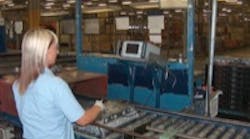Montupet supplies several European and American automakers, who note the group's capabilities in designing, developing, and manufacturing aluminum auto parts. In addition to cylinder heads, Montupet's various plants produce master cylinders, gear boxes, manifolds, housings, and wheel rims, among other aluminum components.
In Belfast, cylinder heads are produced by low-pressure casting, with tight control of diefilling to preserve the quality of the cast alloy. After casting, the heads are "tubed" to debur all waterways and bores, and then heat-treated. The finished heads are supplied to Ford, or other automotive manufacturers, with a 0.7mm skin on the combustion face — which is carefully removed by the customer before the head is fitted to the engine block.
It is important that this mating surface revealed by the final skimming is absolutely perfect. However, even very precise casting techniques carry a risk of shrinkage. To ensure that any such flaws are detected before the heads are delivered to the customer, Montupet explored eddy-current techniques as a way to detect any signs of sub-surface shrinkage or porosity. This inquiry led to installing the Vector 2D system, on loan from a GE Inspection Technologies distributor, to carry out preliminary trials.
The trials were so successful that an inspection station was set up on the production line. The Vector 2D is calibrated to detect a 0.7-mm hole — 0.7 mm below the surface — to ensure that any cylinder heads delivered to the customer will be free of flaws when they are treated to the final skimming. Setting up the instrument is a simple, and intuitive: the single page set-up menu eliminates complicated procedures.
Explaining his decision to opt for the Vector 2D, Andy Chambers, a Montupet process engineer at Belfast, said, "I particularly liked the instrument's large screen, which makes it easy for the operator to come to a quick ‘sentencing' decision. The inspection process is now a very fast and reliable operation, as the operator just needs to scan the probe over a template area on the casting.
"I also find the analogue outputs useful," Chambers continued, "as I can record these for inspection traceability, a feature which is particularly helpful for monitoring night shift operations" In fact, so successful was the initial installation that a second Vector 2D was been installed on the production line to increase overall productivity.
Low-frequency eddy current technology is ideal for this application, as it can detect sub-surface flaws in aluminum at depths up to 10mm. The Vector 2D was designed to take advantage of this ability, and provides fast and reliable, on-line and off-line inspection in metalcasting and automotive operations. This can identify defects such as surface-breaking and sub-surface cracks in components, regardless of complex geometry.
Vector 2D also offers high probe-sample refresh rates to allow accurate inspection at high line speeds, and incorporates state-of-the-art filter technology to provide the best signal-to-noise ratio of any comparable instrument on the market. As well as operating as a stand-alone unit, it can be integrated into automated systems, where its output can be used to activate a paint marking system, an alarm signal, or an accept/reject gate, to minimize the need for human operation during inspection. This is particularly useful when the instrument is used for hardness sorting, where it detects differences in conductivity.
Real-time display of all inspections is provided on an easily viewable LCD, with capacity to save up to 50 traces and 50 settings internally. Data can be downloaded to a PC via an RS232 connection, or via a standard I/O connector to an A to D board or a strip chart recorder.









